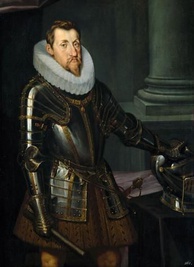
Ferdinand II
Ferdinand II was a Roman Emperor originally from a side branch of the Habsburg dynasty - the Tyrol branch. His rule was marked by the Thirty Years War and the Catholic counterreformation.
Ferdinand was supposedly a relatively mild man and a very kind father, but he was also less than bright, so most major decisions were taken by his counselors, in particular by Jesuits considering his strong religious disposition. He suffered from a form of paranoia, which his counselors sometimes exploited to get the king where they wanted.
He was the nephew of Ferdinand I and received a strict Catholic education in a Jesuit college. In his early youth he ruled over Styria, Carinthia, and Carniola. Since Emperor Matthias had no children, he was his direct successor.
When it came to governance, Ferdinand was uncompromising and intolerant towards the Protestants, which wasn’t seen well by the mostly reformist Czech lands. Ferdinand’s position provoked tensions, which culminated with the Defenestration of Prague in 1618. A year later, Ferdinand was deposited and replaced by Frederick, Elector Palatinate, as
the King of Bohemia.
Ferdinand concluded agreements with his Catholic relatives, which later led to the defeat of the Czech Estates’ troops on the White Mountain in 1620. This event marked the beginning of the long period called the Thirty Years War and suppressed the last obstacles on Ferdinand’s path to power over the Czech lands.
Right after his re-accession to the throne he initiated severe repressive actions and launched the recatholization of the country. The first stage of this process culminated with the execution of 27 Czech lords and knights on the Old Town Square. In 1627, Ferdinand issued the Renewed Land Ordinance, by which he severely disturbed the system of the Estates and strengthened absolutism.
During the war, the power of the capable military leader Albert of Wallenstein grew to the point that the king started worrying about him. He believed the rumors that Wallenstein was trying to seize the Bohemian crown and so he had him murdered, or at least expressed his tight-lipped consent for his murder in Cheb in 1634. Ferdinand II died in the middle of the raging war in 1637.






